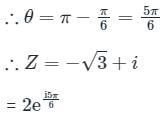Test: Representation of Complex Numbers (May 13) - JEE MCQ
Test Description
10 Questions MCQ Test - Test: Representation of Complex Numbers (May 13)
Test: Representation of Complex Numbers (May 13) for JEE 2025 is part of JEE preparation. The Test: Representation of Complex Numbers (May 13) questions and answers have been prepared
according to the JEE exam syllabus.The Test: Representation of Complex Numbers (May 13) MCQs are made for JEE 2025 Exam.
Find important definitions, questions, notes, meanings, examples, exercises, MCQs and online tests for Test: Representation of Complex Numbers (May 13) below.
Solutions of Test: Representation of Complex Numbers (May 13) questions in English are available as part of our course for JEE & Test: Representation of Complex Numbers (May 13) solutions in
Hindi for JEE course.
Download more important topics, notes, lectures and mock test series for JEE Exam by signing up for free. Attempt Test: Representation of Complex Numbers (May 13) | 10 questions in 20 minutes | Mock test for JEE preparation | Free important questions MCQ to study for JEE Exam | Download free PDF with solutions
Test: Representation of Complex Numbers (May 13) - Question 1
Express z = 1 + i in the polar form.
Detailed Solution for Test: Representation of Complex Numbers (May 13) - Question 1
Test: Representation of Complex Numbers (May 13) - Question 2

Which below option is true for fourth quadrant as per above figure?

Which below option is true for fourth quadrant as per above figure?
Detailed Solution for Test: Representation of Complex Numbers (May 13) - Question 2
Test: Representation of Complex Numbers (May 13) - Question 3
What is the polar form of the complex number 

Detailed Solution for Test: Representation of Complex Numbers (May 13) - Question 3
Test: Representation of Complex Numbers (May 13) - Question 4
What is the polar form of the complex number 
Detailed Solution for Test: Representation of Complex Numbers (May 13) - Question 4
Test: Representation of Complex Numbers (May 13) - Question 5
What is the principal value of amplitude of 
Detailed Solution for Test: Representation of Complex Numbers (May 13) - Question 5
Test: Representation of Complex Numbers (May 13) - Question 6
Represent the complex number Z = - 2 - i 2√3 in the polar form.
Detailed Solution for Test: Representation of Complex Numbers (May 13) - Question 6
Test: Representation of Complex Numbers (May 13) - Question 7
If the area of the triangle on the complex plane formed by the points z, z + iz and iz is 50, then |z| is
Detailed Solution for Test: Representation of Complex Numbers (May 13) - Question 7
Test: Representation of Complex Numbers (May 13) - Question 8
The polar form of -√3 + i will be –
Detailed Solution for Test: Representation of Complex Numbers (May 13) - Question 8
Test: Representation of Complex Numbers (May 13) - Question 9
What is the polar form of the complex number (i15)3?
Detailed Solution for Test: Representation of Complex Numbers (May 13) - Question 9
Test: Representation of Complex Numbers (May 13) - Question 10
Express the complex number 2i using polar coordinates.
Detailed Solution for Test: Representation of Complex Numbers (May 13) - Question 10
Information about Test: Representation of Complex Numbers (May 13) Page
In this test you can find the Exam questions for Test: Representation of Complex Numbers (May 13) solved & explained in the simplest way possible.
Besides giving Questions and answers for Test: Representation of Complex Numbers (May 13), EduRev gives you an ample number of Online tests for practice
Download as PDF







 is the modulus of z and θ is known as the argument or amplitude of z.
is the modulus of z and θ is known as the argument or amplitude of z.










 lies in IVth quadrant.
lies in IVth quadrant.
 is called modulus of given complex number.
is called modulus of given complex number. is called modulus of given complex number.
is called modulus of given complex number.






 is called the modulus of the given complex number.
is called the modulus of the given complex number.






 is called modulus of given complex number.
is called modulus of given complex number.













